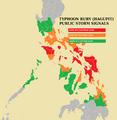Typhoon Hagupit (2014) facts for kids
Typhoon Hagupit was a very strong storm that formed in the western Pacific Ocean in December 2014. In the Philippines, this powerful storm was known as Typhoon Ruby. It was a type of storm called a tropical cyclone, which is a big, spinning system of clouds and thunderstorms.
This typhoon was heading straight for the Philippines. Because of how strong it was, many warnings and notices were sent out to people living there. These warnings helped people get ready and stay safe.
Hagupit officially became a tropical storm on December 1, 2014. Just one day later, on December 2, it grew even stronger and became a full typhoon.
Contents
What Is a Tropical Cyclone?
A tropical cyclone is a huge, rotating storm system that forms over warm ocean waters. It has strong winds and heavy rain. When these storms are very strong, they are called typhoons in the western Pacific Ocean. In other parts of the world, they might be called hurricanes or cyclones.
How Did Typhoon Hagupit Form?
Typhoon Hagupit started as a low-pressure area over the ocean. Warm ocean water gives these storms energy, helping them grow. As the storm gathered more energy, its winds started to spin faster and faster. This is how it became a tropical storm and then a typhoon.
Warnings and Safety in the Philippines
When a typhoon like Hagupit is approaching, it's very important for people to be warned. In the Philippines, weather agencies put out special storm warnings. These warnings tell people about the storm's path, how strong it is, and what to do to stay safe. People might need to evacuate their homes and go to safer places.
Images for kids
See also
 In Spanish: Tifón Hagupit (2014) para niños
In Spanish: Tifón Hagupit (2014) para niños



